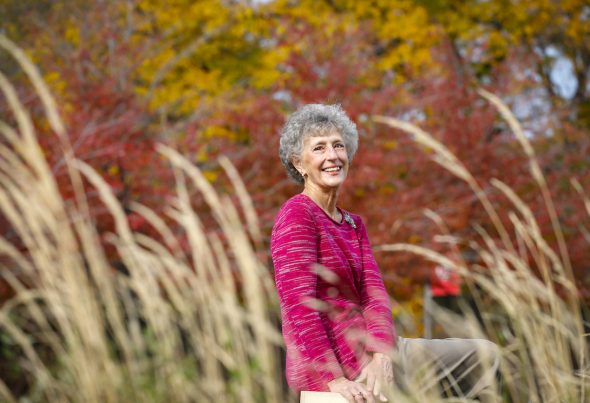UIC’s Electronic Visualization Laboratory director retires after 34 years

By Andrea Poet
Maxine Brown, director of UIC’s Electronic Visualization Laboratory (EVL), retired in October, after a 34-year career at the interdisciplinary research lab, which specializes in collaborative visualization, virtual reality, visual data science, and advanced computing and networking infrastructure. She joined EVL as associate director in 1986 and became the lab’s director in 2014.
During her tenure, she was part of EVL teams that conducted pioneering work in scientific visualization, advanced virtual reality and high-speed networking infrastructure. One of the lab’s best-known inventions includes the CAVE™ virtual-reality environment; a way for accessing, sharing, and interacting with ultra-high-resolution 3D images on tiled display walls. This was followed by the CAVE2™ hybrid-reality environment, the SAGE™ scalable adaptive graphics environment, the SAGE2™ scalable amplified group environment, and the SAGE3™ smart amplified group environment.
“I’ve known Maxine for over 25 years, and she has always been strongly committed to building the future by creating new infrastructure and applications, encouraging multidisciplinary collaborations and multi-national partnerships, organizing conferences for researchers and the public to meet and share knowledge, and mentoring students into future leaders,” said Andy Johnson, interim director and director of research at EVL and professor of computer science.
Tom DeFanti, co-director emeritus of EVL and distinguished professor of computer science, who co-founded and co-directed EVL with Dan Sandin, emeritus professor of art, hired Brown and credits her with helping grow EVL exponentially.
“Maxine taught me how to write proposals — I only knew how to program computers and shoot and edit videotapes. I still use the template Maxine generated in Word 25 years ago — and about $80 million dollars (in grants) later,” DeFanti said.
Brown was a recipient of the 1990 UIC Chancellor’s Academic Professional Excellence (CAPE) award, the 1998 Association for Computing Machinergy (ACM) Special Interest Group on Computer Graphics and Interactive Techniques (SIGGRAPH) Outstanding Service Award, and the 2001 UIC Merit Award.
Below is an interview with Brown, lightly edited for clarity.
You joined the lab in 1986. What made you want to work at EVL?
I always liked explaining things to people. I enjoyed being a teaching assistant in graduate school. I wrote documentation for the marketing people when I was a programmer in industry, and I organized the technical program for user group meetings when I moved into corporate marketing. I never thought I could work in academia with a MS in computer science (I left grad school with an A.B.D – All But Dissertation). EVL was beyond special, as it was both academia and computer graphics, with an emphasis on the arts. EVL was the absolute best of all worlds.
What are some of your proudest moments?
EVL already had some major achievements before I joined. For instance, EVL had a role in developing the computer graphics for the first “Star Wars” movie, though EVL has many other things about which to brag. But since my arrival, ‘Team EVL’ and I had many seminal accomplishments.
I was co-editor of the landmark NSF-report “Visualization in Scientific Computing” that coined the term “scientific visualization” (1987). EVL invented the CAVE virtual-reality environment and pioneered “tele-immersion,” or virtual-reality over distance (1992).
EVL, along with Northwestern University and Argonne National Laboratory, created STAR TAP (1997), the research and education network connection facility for international traffic located in downtown Chicago. STAR TAP was followed by StarLight (2001), which is still the largest research and engineering advanced networking facility in the world.
EVL was a lead institution with UC San Diego’s Calit2-Qualcomm Institute of the NSF-funded “OptIPuter” initiative (2002-2009) that envisioned a future in which high-speed networks were the backbone of a distributed computer whose components (compute, storage, visualization) could be located anywhere in the world.
EVL’s SAGE collaboration and visualization software came out of that work (2004), and lessons learned from that project became EVL’s motivator for all subsequent systems architecture research. And, over the past decade, EVL created the next-generation CAVE2 system (2012) as well as SAGE2 (2014) and now SAGE3 (2020).
EVL inventions were adopted by a wide variety of application domains, from medical to earth sciences to astronomy, which I found fascinating, and these inventions created commercialization licensing opportunities, patents, and royalties, which kept us very busy.
How would you sum up the impact of EVL on digital media and computer graphics?
EVL has been, and continues to be, one of several highly-regarded computer graphics and visualization research laboratories worldwide. However, EVL has always looked at the bigger picture of digital media in the context of today’s cyberinfrastructure ecosystem — from creating (compute/visualization) to enhancing (i.e., multimedia, such as audio and touch), manipulating (image processing), interacting (human-computer interfaces), streaming (networks), sharing (computer supported collaborative work), and immersing one’s self (virtual reality) into the data.
All EVL students get great jobs upon graduation and take with them not only their education, but EVL’s history of innovation, culture of inclusivity, and emphasis on interdisciplinary collaborations among scientists, artists, and engineers.
What do you hope to see in the near- or long- term future for the lab?
Big Data keeps getting bigger (e.g., higher-resolution instruments, Internet of Things’ sensor data, drones taking 360-degree photos and video, autonomous vehicles). Research and development globalization makes the world keep getting smaller, so techniques to capture, store, move, process, and analyze visual information among collaborators worldwide continues to grow. All these pursuits, across domains, open many opportunities for EVL.
What are you looking forward to in retirement?
While I will miss all the energy, expertise, and creativity at EVL, I welcome more personal time to explore old hobbies and new interests.
Categories
